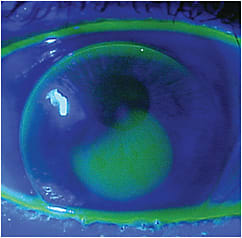Troubleshooting a corneal GP lens fit is often straightforward when good empirical data is collected and if the patient’s cornea is healthy and has a regular shape. Small changes in base curve radius (BCR) or overall diameter (OAD) may be all that are needed to solidify a good fit. However, with more unusual or irregular corneas, abnormal lid tension, corneal pathology, or other complicating factors, it is sometimes necessary to modify other available GP lens parameters to perfect a fit. The back-optic-zone diameter (BOZD), eccentricity, peripheral curve radius and width, center thickness, and other adjustable lens options all contribute to the lens-to-cornea fitting relationship and may be helpful tools when changes to BCR and OAD aren’t enough.
Adjusting a Corneal GP for a Keratoconus Patient
BOZD is particularly useful when fitting patients who have keratoconus with corneal GP lenses. For example, an 80-year-old female patient had worn GP lenses for many years until symptoms of pain with lens wear developed OD. She was referred for help with achieving a better lens fit. The patient was unable to apply scleral lenses and was very motivated to continue with corneal GPs. She presented with a reasonably good fit OS, but the lens OD was very steep, which caused excessive inferior decentration and resulted in edge seal-off and significant midperipheral staining (Figure 1).

As the OAD of the lens seemed reasonable given her corneal diameter and shape, and the design of the lens was deemed appropriate based on her corneal topography and keratoconus findings, the BCR and BOZD were chosen as the most appropriate parameters to change. Flattening the BCR alone (to the degree necessary to improve centration and comfort) risked bearing on the apex of the cone, so I changed the BOZD as well. Reducing the BOZD allowed the BCR to remain slightly steeper and to better vault the apex while the rest of the lens more quickly flattened out toward the periphery. With these two changes, the patient experienced a much more comfortable fit with better centration, edge lift, and some upper lid attachment, without any bearing on the cone apex (Figure 2).

Influence Both Fit and Vision
The relationship between BOZD and BCR is a very close one. On a regular cornea, a 0.25D change in BCR requires approximately a 0.5mm change in BOZD to maintain the same fit appearance. Smaller BOZDs will result in a flattening effect; conversely, larger BOZDs can be used to increase sagittal depth and to steepen a fit.
Beyond fit, changes in BOZD can also affect vision. Modifying BOZD size can reduce flare and glare symptoms and can help improve the effectiveness of multifocal lenses (both larger and smaller depending on the multifocal design and patient-specific symptoms). Additionally, a smaller BOZD can reduce flexure in some cases. When combined with other parameters and with the input of a laboratory consultant’s knowledge about lens design, BOZD can be a useful tool in improving GP lens fits. CLS




